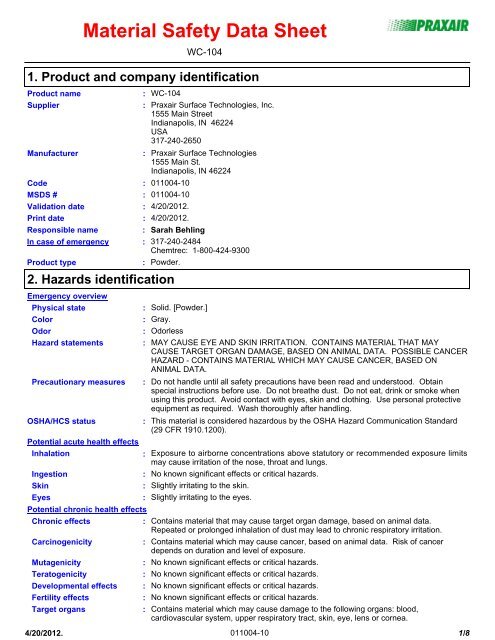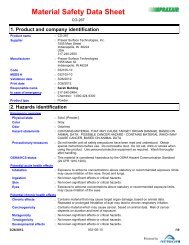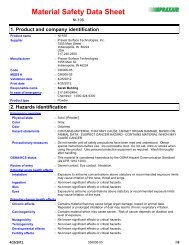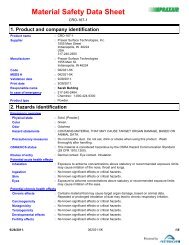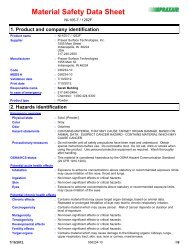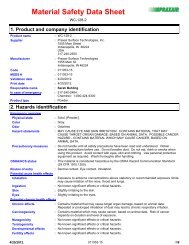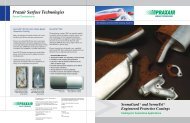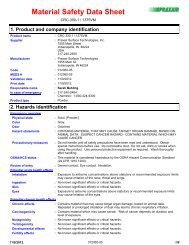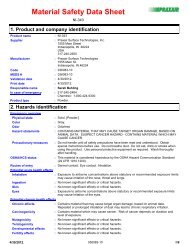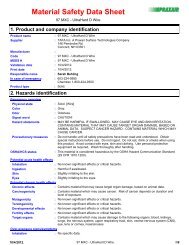Material Safety Data Sheet - Praxair Surface Technologies
Material Safety Data Sheet - Praxair Surface Technologies
Material Safety Data Sheet - Praxair Surface Technologies
You also want an ePaper? Increase the reach of your titles
YUMPU automatically turns print PDFs into web optimized ePapers that Google loves.
Product nameSupplierManufacturerCodeMSDS #Validation datePrint date<strong>Material</strong> <strong>Safety</strong> <strong>Data</strong> <strong>Sheet</strong>WC-1041. Product and company identificationResponsible nameIn case of emergencyProduct type2. Hazards identificationIngestionSkinEyes: WC-104: <strong>Praxair</strong> <strong>Surface</strong> <strong>Technologies</strong>, Inc.1555 Main StreetIndianapolis, IN 46224USA317-240-2650: <strong>Praxair</strong> <strong>Surface</strong> <strong>Technologies</strong>1555 Main St.Indianapolis, IN 46224: 011004-10: 011004-10: 4/20/2012.: 4/20/2012.: Sarah Behling: 317-240-2484Chemtrec: 1-800-424-9300: Powder.Emergency overviewPhysical state: Solid. [Powder.]Color: Gray.Odor: OdorlessHazard statements : MAY CAUSE EYE AND SKIN IRRITATION. CONTAINS MATERIAL THAT MAYCAUSE TARGET ORGAN DAMAGE, BASED ON ANIMAL DATA. POSSIBLE CANCERHAZARD - CONTAINS MATERIAL WHICH MAY CAUSE CANCER, BASED ONANIMAL DATA.Precautionary measuresOSHA/HCS statusPotential acute health effectsInhalation:Potential chronic health effectsChronic effectsCarcinogenicityMutagenicityTeratogenicityDevelopmental effectsFertility effectsTarget organs: Do not handle until all safety precautions have been read and understood. Obtainspecial instructions before use. Do not breathe dust. Do not eat, drink or smoke whenusing this product. Avoid contact with eyes, skin and clothing. Use personal protectiveequipment as required. Wash thoroughly after handling.: This material is considered hazardous by the OSHA Hazard Communication Standard(29 CFR 1910.1200).:::Exposure to airborne concentrations above statutory or recommended exposure limitsmay cause irritation of the nose, throat and lungs.No known significant effects or critical hazards.Slightly irritating to the skin.Slightly irritating to the eyes.: Contains material that may cause target organ damage, based on animal data.Repeated or prolonged inhalation of dust may lead to chronic respiratory irritation.: Contains material which may cause cancer, based on animal data. Risk of cancerdepends on duration and level of exposure.: No known significant effects or critical hazards.: No known significant effects or critical hazards.: No known significant effects or critical hazards.: No known significant effects or critical hazards.: Contains material which may cause damage to the following organs: blood,cardiovascular system, upper respiratory tract, skin, eye, lens or cornea.4/20/2012.011004-101/8
WC-1042. Hazards identificationOver-exposure signs/symptomsInhalationIngestionSkinEyesMedical conditionsaggravated by overexposureSee toxicological information (Section 11): Adverse symptoms may include the following:respiratory tract irritationcoughing: No specific data.: Adverse symptoms may include the following:irritationredness: Adverse symptoms may include the following:irritationwateringredness:Pre-existing disorders involving any target organs mentioned in this MSDS as being atrisk may be aggravated by over-exposure to this product.3. Composition/information on ingredientsName CAS number %Tungsten 7440-33-7 >75Cobalt 7440-48-4 5 - 20Carbon 7440-44-0 1 - 5There are no additional ingredients present which, within the current knowledge of the supplier and in theconcentrations applicable, are classified as hazardous to health or the environment and hence require reporting inthis section.4. First aid measuresEye contactSkin contactInhalationIngestionProtection of first-aidersNotes to physician5. Fire-fighting measures:::::Check for and remove any contact lenses. Immediately flush eyes with plenty of waterfor at least 15 minutes, occasionally lifting the upper and lower eyelids. Get medicalattention immediately.In case of contact, immediately flush skin with plenty of water for at least 15 minuteswhile removing contaminated clothing and shoes. Wash clothing before reuse. Cleanshoes thoroughly before reuse. Get medical attention immediately.Move exposed person to fresh air. If not breathing, if breathing is irregular or ifrespiratory arrest occurs, provide artificial respiration or oxygen by trained personnel.Loosen tight clothing such as a collar, tie, belt or waistband. Get medical attentionimmediately.Wash out mouth with water. Do not induce vomiting unless directed to do so by medicalpersonnel. Never give anything by mouth to an unconscious person. Get medicalattention immediately.: No action shall be taken involving any personal risk or without suitable training. It maybe dangerous to the person providing aid to give mouth-to-mouth resuscitation.No specific treatment. Treat symptomatically. Contact poison treatment specialistimmediately if large quantities have been ingested or inhaled.Flammability of the product :Extinguishing mediaSuitable :Not suitable :Special exposure hazards :No specific fire or explosion hazard.Use an extinguishing agent suitable for the surrounding fire.None known.Promptly isolate the scene by removing all persons from the vicinity of the incident ifthere is a fire. No action shall be taken involving any personal risk or without suitabletraining.4/20/2012.011004-102/8
WC-1045. Fire-fighting measuresHazardous thermaldecomposition productsSpecial protectiveequipment for fire-fighters: Decomposition products may include the following materials:carbon dioxidecarbon monoxidemetal oxide/oxides:Fire-fighters should wear appropriate protective equipment and self-contained breathingapparatus (SCBA) with a full face-piece operated in positive pressure mode.6. Accidental release measuresPersonal precautions :Environmental precautionsMethods for cleaning upSmall spill :Large spill :7. Handling and storageHandlingStorageNo action shall be taken involving any personal risk or without suitable training.Evacuate surrounding areas. Keep unnecessary and unprotected personnel fromentering. Do not touch or walk through spilled material. Avoid breathing dust. Provideadequate ventilation. Wear appropriate respirator when ventilation is inadequate. Puton appropriate personal protective equipment (see Section 8).: Avoid dispersal of spilled material and runoff and contact with soil, waterways, drainsand sewers. Inform the relevant authorities if the product has caused environmentalpollution (sewers, waterways, soil or air).::Move containers from spill area. Vacuum or sweep up material and place in adesignated, labeled waste container. Dispose of via a licensed waste disposalcontractor.Move containers from spill area. Approach release from upwind. Prevent entry intosewers, water courses, basements or confined areas. Vacuum or sweep up materialand place in a designated, labeled waste container. Avoid creating dusty conditions andprevent wind dispersal. Dispose of via a licensed waste disposal contractor. Note: seesection 1 for emergency contact information and section 13 for waste disposal.Put on appropriate personal protective equipment (see Section 8). Eating, drinking andsmoking should be prohibited in areas where this material is handled, stored andprocessed. Workers should wash hands and face before eating, drinking and smoking.Remove contaminated clothing and protective equipment before entering eating areas.Do not get in eyes or on skin or clothing. Do not ingest. Avoid breathing dust. If duringnormal use the material presents a respiratory hazard, use only with adequate ventilationor wear appropriate respirator. Keep in the original container or an approved alternativemade from a compatible material, kept tightly closed when not in use. Empty containersretain product residue and can be hazardous. Do not reuse container.Store in accordance with local regulations. Store in original container protected fromdirect sunlight in a dry, cool and well-ventilated area, away from incompatible materials(see section 10) and food and drink. Keep container tightly closed and sealed until readyfor use. Containers that have been opened must be carefully resealed and kept uprightto prevent leakage. Do not store in unlabeled containers. Use appropriate containmentto avoid environmental contamination.8. Exposure controls/personal protectionIngredientExposure limitsTungsten ACGIH TLV (United States, 2/2010).TWA: 5 mg/m³, (as W) 8 hour(s). Form: InsolubleSTEL: 10 mg/m³, (as W) 15 minute(s). Form: InsolubleNIOSH REL (United States, 6/2009). Notes: Note: The REL alsoapplies to other insoluble tungsten compounds (as W).STEL: 10 mg/m³, (as W) 15 minute(s).TWA: 5 mg/m³, (as W) 10 hour(s).CobaltNIOSH REL (United States, 6/2009). Notes: as CoTWA: 0.05 mg/m³, (as Co) 10 hour(s). Form: Dust and fumesACGIH TLV (United States, 2/2010). Notes: as Co4/20/2012.011004-103/8
WC-1048. Exposure controls/personal protectionOSHA PEL (United States, 6/2010). Notes: as CoTWA: 0.1 mg/m³, (as Co) 8 hour(s).OSHA PEL 1989 (United States, 3/1989). Notes: as CoTWA: 0.05 mg/m³, (as Co) 8 hour(s).Recommended monitoringproceduresEngineering measuresHygiene measuresPersonal protectionRespiratoryHands :EyesSkinEnvironmental exposurecontrols9. Physical and chemical propertiesPhysical stateColorOdorDistributionMelting/freezing point :VOC content :Solubility: If this product contains ingredients with exposure limits, personal, workplace atmosphereor biological monitoring may be required to determine the effectiveness of the ventilationor other control measures and/or the necessity to use respiratory protective equipment.: Use only with adequate ventilation. If user operations generate dust, fumes, gas, vaporor mist, use process enclosures, local exhaust ventilation or other engineering controlsto keep worker exposure to airborne contaminants below any recommended or statutorylimits.: Wash hands, forearms and face thoroughly after handling chemical products, beforeeating, smoking and using the lavatory and at the end of the working period. Appropriatetechniques should be used to remove potentially contaminated clothing. Washcontaminated clothing before reusing. Ensure that eyewash stations and safety showersare close to the workstation location.:::Use a properly fitted, air-purifying or air-fed respirator complying with an approvedstandard if a risk assessment indicates this is necessary. Respirator selection must bebased on known or anticipated exposure levels, the hazards of the product and the safeworking limits of the selected respirator.Chemical-resistant, impervious gloves complying with an approved standard should beworn at all times when handling chemical products.<strong>Safety</strong> eyewear complying with an approved standard should be used when a riskassessment indicates this is necessary to avoid exposure to liquid splashes, mists ordusts. If operating conditions cause high dust concentrations to be produced, use dustgoggles.Personal protective equipment for the body should be selected based on the task beingperformed and the risks involved and should be approved by a specialist before handlingthis product.: Emissions from ventilation or work process equipment should be checked to ensure theycomply with the requirements of environmental protection legislation. In some cases,fume scrubbers, filters or engineering modifications to the process equipment will benecessary to reduce emissions to acceptable levels.: Solid. [Powder.]: Gray.: Odorless: -106/+75u:3410°C (6170°F)0 lbs/gal (0 g/l)10. Stability and reactivityInsoluble in the following materials: cold water and hot water.Chemical stabilityConditions to avoidIncompatible materialsHazardous decompositionproductsPossibility of hazardousreactions: The product is stable.: No specific data.: No specific data.: Under normal conditions of storage and use, hazardous decomposition products shouldnot be produced.: Under normal conditions of storage and use, hazardous reactions will not occur.4/20/2012.011004-104/8
WC-10411. Toxicological informationAcute toxicityConclusion/SummaryChronic toxicityConclusion/SummaryIrritation/CorrosionCarcinogenicityConclusion/SummaryClassificationMutagenicityConclusion/SummaryTeratogenicityConclusion/SummaryReproductive toxicityConclusion/Summary: Not available.: Not available.Product/ingredient name Result Species Score Exposure ObservationTungsten Eyes - Mild irritant Rabbit - 24 hours 500 -milligramsSkin - Mild irritant Rabbit - 24 hours 500 -milligramsConclusion/SummarySensitizerConclusion/Summary: Not available.: Not available.: Not available.Product/ingredient name ACGIH IARC EPA NIOSH NTPCobalt A3 2B - - - -: Not available.: Not available.: Not available.12. Ecological informationEcotoxicityAquatic ecotoxicityConclusion/SummaryPersistence/degradabilityConclusion/SummaryOther adverse effects: No known significant effects or critical hazards.: Not available.13. Disposal considerationsWaste disposal: Not available.: No known significant effects or critical hazards.:OSHAThe generation of waste should be avoided or minimized wherever possible. Significantquantities of waste product residues should not be disposed of via the foul sewer butprocessed in a suitable effluent treatment plant. Dispose of surplus and non-recyclableproducts via a licensed waste disposal contractor. Disposal of this product, solutionsand any by-products should at all times comply with the requirements of environmentalprotection and waste disposal legislation and any regional local authority requirements.Waste packaging should be recycled. Incineration or landfill should only be consideredwhen recycling is not feasible. This material and its container must be disposed of in asafe way. Care should be taken when handling emptied containers that have not beencleaned or rinsed out. Empty containers or liners may retain some product residues.Avoid dispersal of spilled material and runoff and contact with soil, waterways, drainsand sewers.Disposal should be in accordance with applicable regional, national and local laws and regulations.Refer to Section 7: HANDLING AND STORAGE and Section 8: EXPOSURE CONTROLS/PERSONAL PROTECTIONfor additional handling information and protection of employees.4/20/2012.011004-105/8
WC-10414. Transport informationRegulatoryinformationDOT ClassificationUN numberProper shippingname- - --TDG Classification Not- --regulated.MexicoClassificationNotregulated.ADR/RID Class Not- - -regulated.IMDG Class Not- - -regulated.IATA-DGR Class Notregulated.---PG* : Packing groupNotregulated.15. Regulatory informationHCS ClassificationU.S. Federal regulations::Classes PG* Label Additionalinformation- - - -CarcinogenTarget organ effectsTSCA 8(a) PAIR: TungstenTSCA 8(a) IUR Exempt/Partial exemption: Not determinedUnited States inventory (TSCA 8b): All components are listed or exempted.SARA 302/304/311/312 extremely hazardous substances: No products were found.SARA 302/304 emergency planning and notification: No products were found.SARA 302/304/311/312 hazardous chemicals: Tungsten; Cobalt; CarbonSARA 311/312 MSDS distribution - chemical inventory - hazard identification:Tungsten: Immediate (acute) health hazard, Delayed (chronic) health hazard; Cobalt:Delayed (chronic) health hazard; Carbon: Fire hazard, Immediate (acute) health hazard,Delayed (chronic) health hazard----Clean Air Act Section112(b) Hazardous AirPollutants (HAPs)Clean Air Act Section 602Class I SubstancesClean Air Act Section 602Class II SubstancesDEA List I Chemicals(Precursor Chemicals)DEA List II Chemicals(Essential Chemicals)SARA 313Form R - ReportingrequirementsSupplier notification: Not listed: Not listed: Not listed: Not listed: Not listedProduct name CAS number ConcentrationCobalt 7440-48-4 5 - 20Cobalt 7440-48-4 5 - 20SARA 313 notifications must not be detached from the MSDS and any copying and redistribution of the MSDS shallinclude copying and redistribution of the notice attached to copies of the MSDS subsequently redistributed.State regulations4/20/2012.011004-106/8
WC-10415. Regulatory informationMassachusetts: The following components are listed: TUNGSTEN; COBALTNew York: None of the components are listed.New Jersey: The following components are listed: TUNGSTEN; COBALTPennsylvania: The following components are listed: TUNGSTEN; COBALT FUMECalifornia Prop. 65WARNING: This product contains a chemical known to the State of California to cause cancer.Ingredient name Cancer Reproductive No significant risklevelMaximumacceptable dosagelevelCobalt Yes. No. No. No.Canada inventoryInternational regulationsInternational lists :Chemical WeaponsConvention List Schedule IChemicalsChemical WeaponsConvention List ScheduleII ChemicalsChemical WeaponsConvention List ScheduleIII Chemicals16. Other information: All components are listed or exempted.Australia inventory (AICS): All components are listed or exempted.China inventory (IECSC): All components are listed or exempted.Japan inventory: Not determined.Korea inventory: All components are listed or exempted.New Zealand Inventory of Chemicals (NZIoC): All components are listed or exempted.Philippines inventory (PICCS): All components are listed or exempted.: Not listed: Not listed: Not listedLabel requirements :Hazardous <strong>Material</strong>Information System (U.S.A.):MAY CAUSE EYE AND SKIN IRRITATION. CONTAINS MATERIAL THAT MAYCAUSE TARGET ORGAN DAMAGE, BASED ON ANIMAL DATA. POSSIBLE CANCERHAZARD - CONTAINS MATERIAL WHICH MAY CAUSE CANCER, BASED ONANIMAL DATA.HealthFlammabilityPhysical hazards100Caution: HMIS® ratings are based on a 0-4 rating scale, with 0 representing minimal hazards or risks, and 4representing significant hazards or risks Although HMIS® ratings are not required on MSDSs under 29 CFR1910.1200, the preparer may choose to provide them. HMIS® ratings are to be used with a fully implementedHMIS® program. HMIS® is a registered mark of the National Paint & Coatings Association (NPCA). HMIS®materials may be purchased exclusively from J. J. Keller (800) 327-6868.The customer is responsible for determining the PPE code for this material.National Fire ProtectionAssociation (U.S.A.):0FlammabilityHealth10Instability/ReactivitySpecial4/20/2012.011004-107/8
WC-10416. Other informationReprinted with permission from NFPA 704-2001, Identification of the Hazards of <strong>Material</strong>s for EmergencyResponse Copyright ©1997, National Fire Protection Association, Quincy, MA 02269. This reprinted material is notthe complete and official position of the National Fire Protection Association, on the referenced subject which isrepresented only by the standard in its entirety.Copyright ©2001, National Fire Protection Association, Quincy, MA 02269. This warning system is intended to beinterpreted and applied only by properly trained individuals to identify fire, health and reactivity hazards ofchemicals. The user is referred to certain limited number of chemicals with recommended classifications in NFPA49 and NFPA 325, which would be used as a guideline only. Whether the chemicals are classified by NFPA or not,anyone using the 704 systems to classify chemicals does so at their own risk.Date of printing: 4/20/2012.Date of issueDate of previous issue::4/20/2012.No previous validation.Version: 1Prepared by: Not available.Indicates information that has changed from previously issued version.Notice to readerTo the best of our knowledge, the information contained herein is accurate. However, neither the above-namedsupplier, nor any of its subsidiaries, assumes any liability whatsoever for the accuracy or completeness of theinformation contained herein.Final determination of suitability of any material is the sole responsibility of the user. All materials may presentunknown hazards and should be used with caution. Although certain hazards are described herein, we cannotguarantee that these are the only hazards that exist.4/20/2012.011004-108/8


